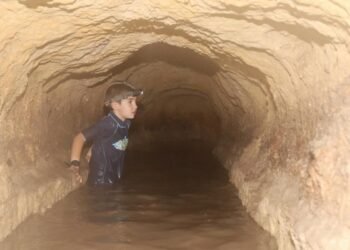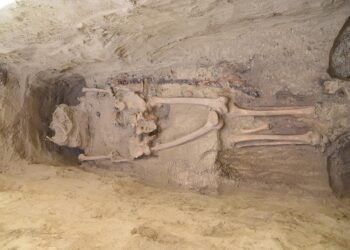Archaeologists from Mexico’s National Institute of Anthropology and History (INAH) have made significant discoveries in La Morita II cave, located in the state of Nuevo León. As part of the ongoing “Prehistory and Historical Archaeology of Northeast Mexico” project, initiated in 2003, researchers uncovered skeletal remains dating back 2,500 to 3,000 years.
The remains—belonging to a baby and two adolescents—were found alongside fragments of basketry, textiles, and plant fibers, likely components of funerary bundles.
Moisés Valadez Moreno, the lead archaeologist overseeing the excavation, suggested that the burial of infants may have involved ritual sacrifice. “According to the chronicles, when the mother died during childbirth or shortly after, the infant was sacrificed and buried with the deceased,” he explained.
Sacrificial practices may have also included infants with congenital disorders or malformations. Valadez Moreno noted that in the case of twin births—perceived as a bad omen—one infant was often chosen to live while the other was separated and buried alive. These findings are consistent with previous discoveries: in 2023, INAH reported uncovering human remains, primarily those of children, in La Morita II, also dating back 3,000 years.
During the current excavation season, archaeologists removed approximately 50 square meters of sediment from the main chamber and 24 square meters from the south chamber. Among the 1,500 artifacts recovered were spearheads, an atlatl (spear-thrower), punches, and polished stone tools, dating from 4,500 to 2,500 years ago.
Remarkably well-preserved perishable materials such as cordage and basketry—dated to around 3,000 years ago—were also found. “These latest findings join the nearly 30,000 cultural remains recovered in La Morita II,” said Valadez Moreno.
In addition to human remains, the cave yielded a wide array of domestic and ritual artifacts, such as awls and polished tools, suggesting that the site had uses beyond burials. The presence of weapons, dried feces, and seeds indicates that La Morita II served as a multifunctional space for daily life, food processing, and ritual activity.
La Morita II is especially noteworthy among prehistoric cave sites in Mexico, which were often used solely for burials. It is also believed to host Mexico’s earliest cave paintings, dating back over 6,000 years. The discovery of marine mollusks—despite the cave’s inland location approximately 300 kilometers from the Gulf of Mexico—suggests long-distance trade or symbolic connections with coastal regions.
Valadez Moreno emphasized the importance of understanding ancient funerary practices in northeastern Mexico. The close proximity of the three sets of remains and their placement within the same soil layer suggest that the individuals may have died at the same time. Further analysis, including osteological and DNA studies, is expected to clarify their relationship.
The discoveries at La Morita II offer a compelling glimpse into the complex cultural history of the region, reflecting diverse lifestyles, trade networks, and ritual practices during Mexico’s Preclassic period.
























Comments 1